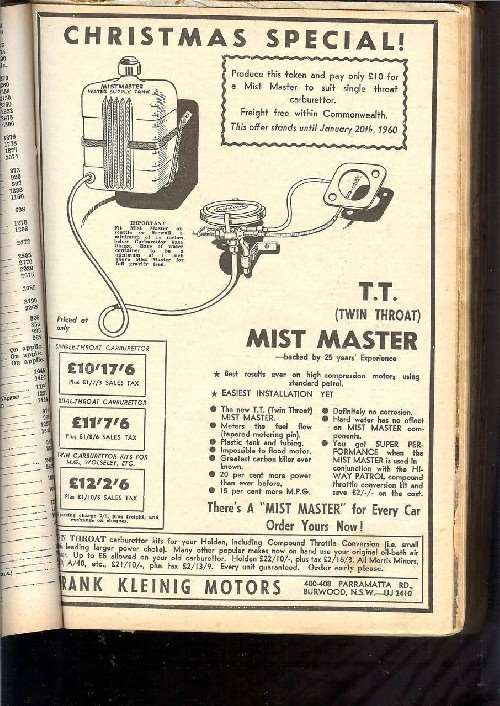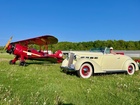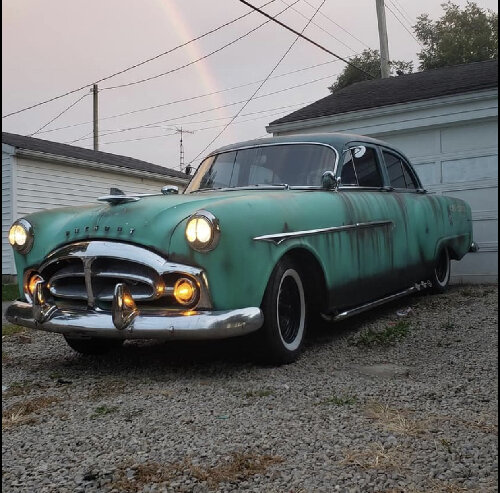|
Re: Pa title correction on a 29 626
|
||||
|---|---|---|---|---|
|
Home away from home

|
G'day k3nn3th,
The numbers that identify your car are all in the engine bay on the LHS: Engine number is stamped on the crankcase near the front engine mount. Chassis number is on the top of the chassis rail just forward of the cowl. Vehicle number is stamped on the plate screwed to the face of the cowl. The large embossed number stamped into the cowl is the thief proof number and does not identify the model. The 1929 6th Series Standard Eight 626/633 cars have engine numbers running from 233017 to 276166. The chassis number and vehicle identification plate number should each have numbers within a few hundred of the engine number. Those numbers only identify the Series of the car ie 626 /633, not body style. The number that identifies the original body is a small brass plate attached to the floor on the RHS in the rear passenger area. As yours has been converted to a truck it will have lost the body plate. If was a 626 Sedan then its body number would have been 333. Are you sure there is a dash in the middle of the engine number, I have not seen that before, 240755 would identify your car as a Sixth Series Standard Eight. Check the other 2 numbers which should be very close to that number. I hope that answers your question?
Posted on: 2013/11/16 2:04
|
|||
|
||||
|
Re: 1921 PackardSingle Six
|
||||
|---|---|---|---|---|
|
Home away from home

|
Richard,
I have just been reminded that a good photo of your car appears on page 22 of an Australian book: "The Second James Flood Book of Early Motoring". The caption under the photo states : Packard First Series Six Tourer owned by Peter Evans , Largs Bay SA. The book was published around 1980.
Posted on: 2013/11/8 16:34
|
|||
|
||||
|
Re: 1922 single six on ebay
|
||||
|---|---|---|---|---|
|
Home away from home

|
Its not one of the standard body styles for that years so its either a later conversion or custom built.
Posted on: 2013/11/8 5:23
|
|||
|
||||
|
Re: 1921 PackardSingle Six
|
||||
|---|---|---|---|---|
|
Home away from home

|
Richard,
Definitely not a 116, its a First Series 126 tourer, these were manufactured between 1922 and 1923. Most of the RHD 126/133 Australian delivered cars have those nice Rudge Whitworth wire wheels and yet they are rarely seen on the US LHD cars. Why this is so I do not know. Unlike a lot of less expensive US cars these cars were manufactured as RHD in US and exported to Australia as complete cars. Looks like a nice example.
Posted on: 2013/11/8 5:20
|
|||
|
||||
|
Re: 1921 PackardSingle Six
|
||||
|---|---|---|---|---|
|
Home away from home

|
Richard,
The engine number 26576 corresponds to a First Series (1922-3) car and the serial number U2649 would also fit that engine number if it had one more digit say U26490. Those two numbers are usually within a few hundred of each. I assume the Serial number is stamped on a plate on the firewall behind the dash. Maybe its not the original plate or it was incorrectly stamped. What is the body style, the 116 bodies are very different to the 126 cars if you post a photo we might recognise the car and be able to give you more information. Did you purchase it from Australia recently?
Posted on: 2013/11/7 16:14
|
|||
|
||||
|
Re: Water Injection
|
||||
|---|---|---|---|---|
|
Home away from home

|
Thanks Gusha for an excellent collection of references on this interesting topic, the following from the Wikipedia reference struck a chord:
"Some degree of control over the water injection is important. It needs to be injected only when conditions within the engine would otherwise be sufficient to cause detonation or other undesirable effects. This normally occurs when the engine is heavily loaded and running at full power, however may occur outside of these times in specialized engines or applications. Otherwise injecting water cools the combustion process unnecessarily, resulting in negative effects such as reduced efficiency or power." This indicates why the simple, largely DIY devices, like the early "Mist Master" unit above were not very effective although the NZ article suggests otherwise. With modern engine management systems using a computer to precisely control mixture, ignition timing and valve timing it would surely be possible to introduce water with the same precise control over flow rate and timing. I would guess it is not necessary because the modern controls have the combustion conditions close to optimum. I think Dave's suggestion for controlling pre-ignition in our Packards by increasing the octane rating and advancing the spark is the most practical solution. The power and fuel savings claimed for water injection must be regarded with a great deal of scepticism and improved engine cooling as originally raised by JP does not appear to be a benefit.
Posted on: 2013/10/29 17:40
|
|||
|
||||
|
Re: Water Injection
|
||||
|---|---|---|---|---|
|
Home away from home

|
As described in my earlier post, one way of getting the water into the inlet manifold is to make a plate to fit between the carburettor and the inlet manifold with a water line attached to the edge of the plate as shown in this advertisement for one such system from about 1960.
Posted on: 2013/10/29 3:54
|
|||
|
||||
|
Re: Water Injection
|
||||
|---|---|---|---|---|
|
Home away from home

|
Back in the 1950's our family car was a 1938 Chev. It was inclined to " ping" or pre-ignite excessively however this did not happen in cold damp weather.
At the time a locally made water/alcohol injector kit was being actively promoted. It was basically a reservoir in the engine bay with a pipe to a metering valve on the edge of a plate that sandwiched between the carburettor and the inlet manifold . The water / alcohol mixture was injected or sucked in through the metering valve on the edge of this plate. My father fitted one of these to the Chev, reasoning that it should simulate the cold damp conditions that suited the car so well. It did not work. He spent a lot of time adjusting the flow rate and the mixture of water and alcohol and water alone but it did not stop the car pinging, make it run and better or improve the economy.
Posted on: 2013/10/26 1:55
|
|||
|
||||
|
Re: 1929 Reversing Light Switch
|
||||
|---|---|---|---|---|
|
Home away from home

|
Dave, Thanks for looking. Might have to improvise , Packardbarry's starter switch solution is interesting. There is always a way.
Posted on: 2013/10/15 16:06
|
|||
|
||||

 (173.53 KB)
(173.53 KB)







